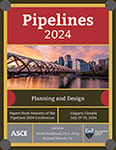Thinking Outside the Reservoir: How TRWD Is Using Constructed Wetlands to Defer Building the Next Reservoir
Publication: Pipelines 2024
ABSTRACT
Due to a need for additional water supply compounded by urban growth and record droughts in Texas, many utilities are looking to supplement their water supplies by building new reservoirs or undertaking other large and expensive water supply projects. As an alternative source of raw water, Tarrant Regional Water District (TRWD) is using constructed wetlands to defer construction of new reservoirs. TRWD is designing and permitting the new Cedar Creek Wetlands. The purpose of the project is to withdraw water from the Trinity River, pass it through a wetland system for natural treatment, and then pump the polished water into the Cedar Creek Reservoir. This will increase TRWD’s water supply, especially during periods of drought, at a lower cost. This paper will discuss three main topics: the purpose and benefit of constructed wetlands, including TRWD’s experience using their George W. Shannon Wetlands located at Richland Chambers Reservoir; TRWD’s efforts and lessons learned over the past 10 years in planning for the project; and technical considerations for moving water through the wetlands system. This will be the first paper on this project and future papers will focus on the design and construction of large diameter pipelines and facilities. Wetlands improve water quality, control erosion, and enhance stream flows while providing habitat for diverse species and offering recreational opportunities. The constructed wetland projects discussed in this paper utilize these natural processes to treat effluent dominated river water while providing a dependable water supply for TRWD’s customers. They have proven to be more cost effective and yield a net environmental benefit when compared to the construction of large surface water reservoirs. In 2013, TRWD proceeded with a 30% design of the Cedar Creek Wetlands system, to allow TRWD to secure the property needed for the project. Early planning resulted in substantial cost savings for TRWD for land and easements. The Cedar Creek Wetlands system has a design capacity of 175,000 acre-feet per year, and consists of a raw water intake and river pump station that sends flow through two miles of parallel 78-in. and 48-in. pipelines to 2,550 wetted acres of treatment wetland cells, a finished water intake and pump station that sends flow through a 10-mi long, 90-in. pipeline to a two-cell balancing reservoir, energy dissipation structure, and outfall to the Cedar Creek Reservoir. This paper will also examine TRWD’s primary technical considerations for moving water through each component of the wetlands system.
Get full access to this chapter
View all available purchase options and get full access to this chapter.
Information & Authors
Information
Published In
History
Published online: Aug 30, 2024
Authors
Metrics & Citations
Metrics
Citations
Download citation
If you have the appropriate software installed, you can download article citation data to the citation manager of your choice. Simply select your manager software from the list below and click Download.
